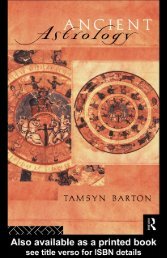Hands of Light – Guide to Healing - Soul Circles
Hands of Light – Guide to Healing - Soul Circles
Hands of Light – Guide to Healing - Soul Circles
You also want an ePaper? Increase the reach of your titles
YUMPU automatically turns print PDFs into web optimized ePapers that Google loves.
clash. This "knowing" can be explained by the<br />
harmony or disharmony in our field interactions.<br />
Relativity<br />
In 1905, Albert Einstein published his Special<br />
Theory <strong>of</strong> Relativity and shattered all the principal<br />
concepts <strong>of</strong> the New<strong>to</strong>nian world view. According<br />
<strong>to</strong> relativity theory, space is not<br />
three-dimensional, and time is not a separate<br />
entity. Both are intimately connected and form a<br />
four-dimensional continuum, "space-time."<br />
Thus, we can never talk about space without<br />
time, and vice versa. Furthermore, there is no<br />
universal flow <strong>of</strong> time; i.e. time is not linear, nor<br />
is it absolute. Time is relative. That is, two observers<br />
will order events differently in time if<br />
they move with different velocities relative <strong>to</strong> the<br />
observed events. Therefore, all measurements<br />
involving space and time lose their absolute significance.<br />
Both time and space become merely<br />
elements <strong>to</strong> describe phenomena.<br />
According <strong>to</strong> Einstein's theory <strong>of</strong> relativity,<br />
in certain conditions two observers can even see<br />
two events in reverse time; i.e., for observer 1,<br />
event A will occur before event B, while for observer<br />
2, event B will occur before event A.<br />
Time and space are so basic <strong>to</strong> our descriptions<br />
<strong>of</strong> natural phenomena and ourselves that<br />
their modification entails a modification <strong>of</strong> the<br />
whole framework that we use <strong>to</strong> describe nature<br />
and ourselves. We have not yet integrated this<br />
part <strong>of</strong> Einstein's relativity in<strong>to</strong> our personal<br />
lives: For example, when we get a psychic flash<br />
<strong>of</strong> a friend in trouble, say about <strong>to</strong> fall down the<br />
stairs, we check the time and call the person as<br />
soon as we can <strong>to</strong> see if she is all right. We also<br />
want <strong>to</strong> know if such a thing happened in order<br />
<strong>to</strong> validate our insight. We call, and she has had<br />
no such experience. We conclude that it was<br />
our imagination playing tricks on us, and we<br />
invalidate our experience. This is New<strong>to</strong>nian<br />
thinking.<br />
We must see that we are experiencing a phenomenon<br />
that cannot be explained by New<strong>to</strong>nian<br />
mechanics, but we are using New<strong>to</strong>nian<br />
mechanics <strong>to</strong> validate our super-sensory experi-<br />
Parallels Between Haw We See Ourselves and Reality and Western Scientific Views 23<br />
ence. In other words, what we saw was a real<br />
experience. Since time is not linear, it may have<br />
already occurred. It may occur at the time we<br />
see it, and it may occur in the future. It may<br />
even be a probable occurrence that never manifests<br />
itself. Just because it didn't happen at the<br />
time we tried <strong>to</strong> correlate it, by no means proves<br />
that our insight about the possibility was wrong.<br />
If, however, within our insight about our friend,<br />
we also saw a calendar and a clock with New<strong>to</strong>nian<br />
time on it, our insight would be such as <strong>to</strong><br />
include that information about the space-time<br />
continuum <strong>of</strong> the event. It would be easier <strong>to</strong><br />
validate in New<strong>to</strong>nian physical reality.<br />
It is time <strong>to</strong> s<strong>to</strong>p invalidating experience that<br />
lies outside our New<strong>to</strong>nian way <strong>of</strong> thinking and<br />
broaden our framework <strong>of</strong> reality. We all have<br />
had experiences <strong>of</strong> time speeding up or <strong>of</strong> losing<br />
track <strong>of</strong> time. If we become pr<strong>of</strong>icient in observing<br />
our moods, we can see that our personal<br />
time varies with the mood we are in and with<br />
the experiences we are having. For example, we<br />
see that time is relative when we experience a<br />
very long, frightening period just before our car<br />
crashes or barely misses another, oncoming car.<br />
This time, measured by the clock, is a few seconds;<br />
however, <strong>to</strong> us, time appears <strong>to</strong> have<br />
slowed down. Experienced time is,not measurable<br />
by a clock because a clock is a New<strong>to</strong>nian<br />
device designed <strong>to</strong> measure the linear time defined<br />
by New<strong>to</strong>nian mechanics.<br />
Our experience exists outside the New<strong>to</strong>nian<br />
system. Many times, we have experienced meeting<br />
someone after several years separation; it is<br />
as if we had just seen them yesterday. In regressional<br />
therapy, many people have experienced<br />
childhood events as if they were occurring in the<br />
present. We also find our memory has ordered<br />
events in a different sequence from someone<br />
else who has also experienced those events. (Try<br />
comparing childhood memories with your siblings.)<br />
The Native American culture, which didn't<br />
have clocks <strong>to</strong> create linear time, divided time<br />
in<strong>to</strong> two aspects: the now and all other time.<br />
The Australian aborigines also have two kinds <strong>of</strong><br />
time: the passing time and the Great Time.<br />
What occurs in the Great Time has sequence,<br />
but it cannot be dated.




